Stad Ship Tunnel – The world’s biggest ship tunnel
The Stad ship tunnel is an investment in Norway’s future. A significant portion of Norwegian values are linked to the Norwegian coast, and the sea. The seafood industry is predicted to grow formidably, and the Norwegian maritime industry is a world leader in making sea transport emission-free. The sea is the transport artery of the future and the Stad ship tunnel will make sea transport safer, more efficient, and more environmentally friendly. The Stad ship tunnel is necessary to achieve the political goal of moving transport from road to sea and will facilitate safe and environmentally friendly sea transport in the coastal and maritime industries in the future.
The Stad ship tunnel interconnects Western Norway. The completion of a ship connection between Bergen and Ålesund creates new housing and labour markets from the Ålesund region, via the maritime cluster in Sunnmøre through the business towns of Måløy and Florø.
illustration image.

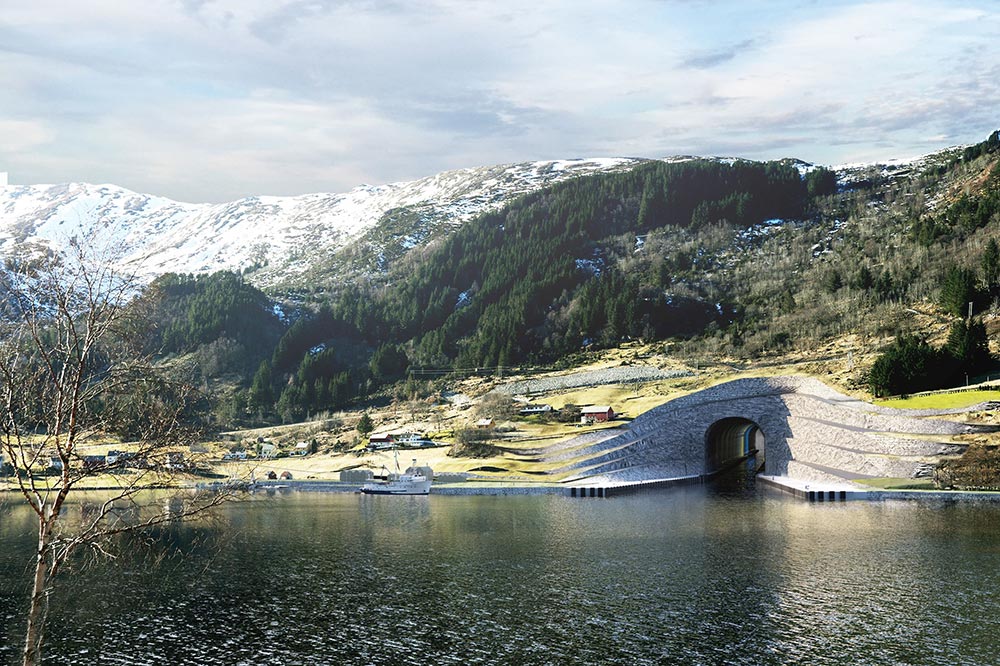
ILLUSTRASJON: KYSTVERKET / SNØHETTA
Why Stad Ship Tunnel?
Safety alon the West Coast
The Stad ship tunnel will ensure a safer and more efficient sailing past Stadhavet, the most weather-exposed and most dangerous stretch of the sea we have along the Norwegian coast.
Kråkenes lighthouse, located just south of Stad, is the metrological weather station with the most storm days in Norway, with many years over 100 days recorded. The combination of wind, currents, and waves makes this stretch a particularly demanding area along the Norwegian coast.
The combinations of ocean currents and subsea topography create particularly complex and unpredictable wave conditions. Very high waves of up to 30 meters can come from different edges at the same time and create critical situations for vessels. Heavy waves can also linger for several days after the wind has calmed down, which in turn leads to difficult sailing conditions even on quiet days.
Since World War II there have been several shipwrecks and near misses on Stadhavet, and 34 people have drowned. The completion of the Stad ship tunnel significantly enhances the safety of seafarers. Forecasts of more frequent extreme weather and generally less acceptance of risk in society further increases the need for the tunnel.
Value and Supply Chain Enhancement
For commercial shipping, the Stad ship tunnel will mean safer deliveries, less waiting time, shorter transport time, and better quality retention of raw materials transported past Stad. Fishing vessels, Bilge well vessels, service vessels, container ships, and cruise ship will benefit daily from the tunnel.
In bad weather, fishing vessels are unwilling to cross Stadhavet to deliver goods due to increased wait time and catch deterioration, limiting delivery options, and prices. Furthermore, the aquaculture industry has lost income due to wait time in factories. The world’s largest fish farming company, Mowi, has therefore been strongly committed to the Stad ship tunnel. Mowi has one of the world’s largest reception facilities for salmon at Eggebøsnes, on the north side of Stad and most of its fish farms south of Stad.
Stadhavet is a challenge for Bilge well vessel, service vessels, container ships, and especially towing equipment to the industry that must cross the exposed sea area. Rostein, one of the largest Bilge well vessels companies in the country, transports salmon to the salmon slaughterhouse at Eggesbøneset and states that 20 percent of the Bilge well vessels are delayed due to the weather conditions at Stad.
Norway has ambitions to become the world’s leading seafood nation, and the Norwegian seafood industry is predicted to have formidable growth in the future. Construction of the Stad ship tunnel is an important element of this growth.
More goods from road to sea
A safer and more efficient sailing past Stad will significantly ease sea transportation and reduce the number of trains carrying seafood through Central and Eastern Norway. From all over the coast, fresh fish exports to the continent are increasing. Today, much of the goods transport is by trailers, largely due to the disadvantages of rounding the uncertain Stadhavet. The Stad ship tunnel will ensure good accessibility and regularity for sea transport around Stad and will help to move heavy traffic away from a congested road network. This will save both operating costs and the environment and lead to saved wear on the roads.
The Norwegian seafood industry is predicted to grow formidably in the future, while capacity and standards on Norwegian roads have already been exceeded. The Stad ship tunnel is important for regularity and opens new keel transport solutions for fresh seafood with cruise ships to the continent.
Environmental benefits
Realization of the Stad ship tunnel leads to shorter travel time, less fuel consumption, and less CO2 emissions. This is shown in a report prepared by Kongsberg Maritime*. The report observed differences in fuel consumption and CO2 emissions between the external shipping lane on Stadhavet and the internal shipping lane simulated via the ship tunnel. The comparison shows a significant difference between the two alternative routes in favour of choosing the ship tunnel under normal winter wave conditions for Stadhavet. Fuel consumption is reduced between 60 percent (for ships around 40 meters) to 30 percent (ships around 140 meters) when choosing the simulated Stad ship tunnel route.
* Report: «Drivstoff- og tidsforbruk ved passering av Stad og gjennom tunnel», Rolls Royce Marine, 12.15.18.
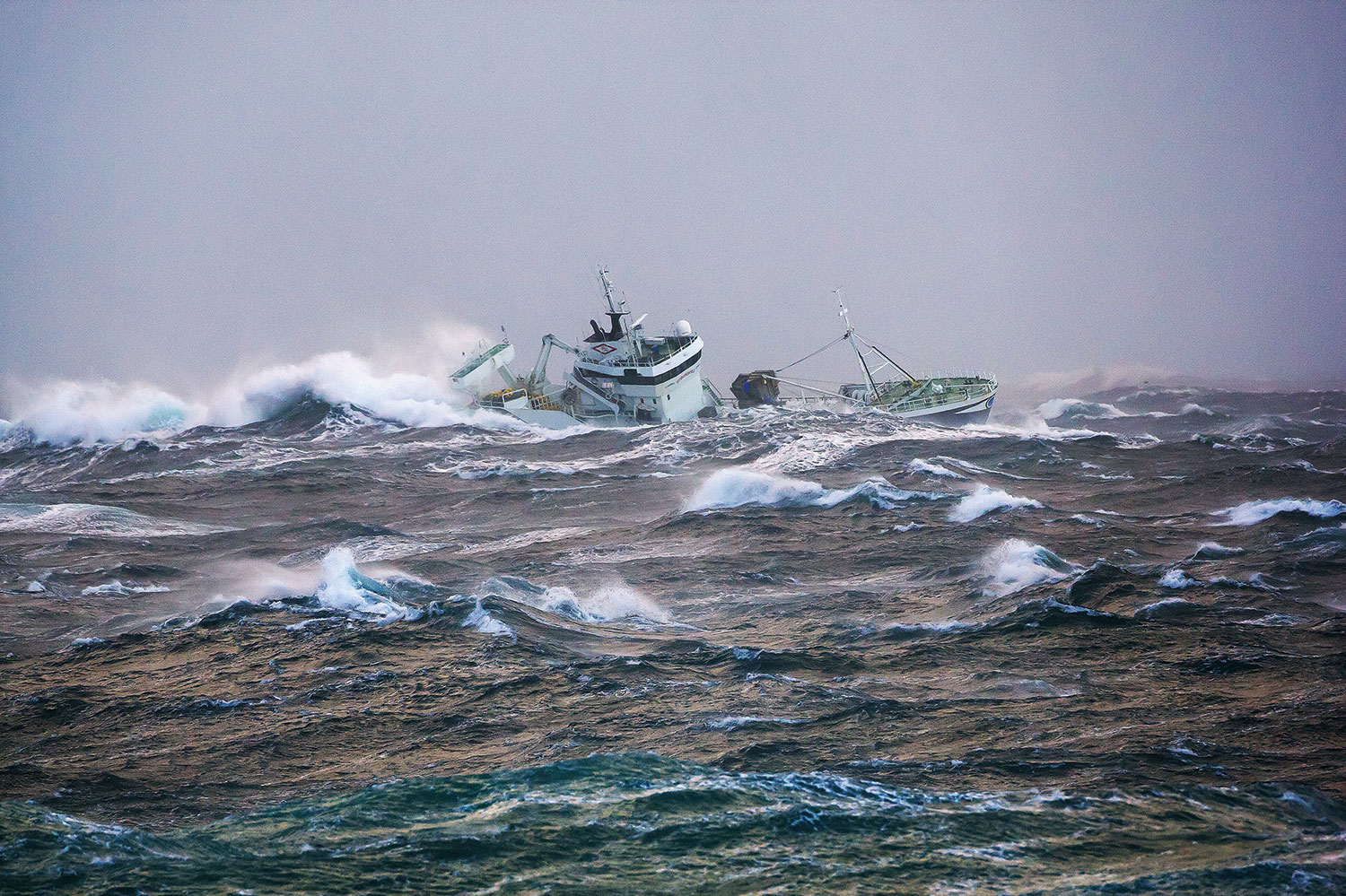
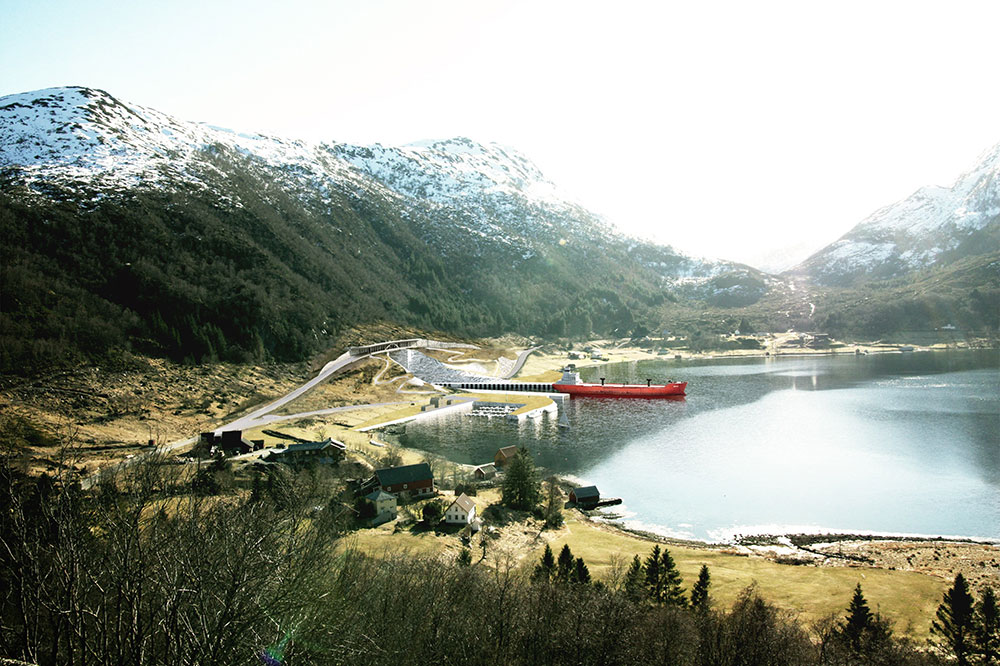
ILLUSTRASJON: KYSTVERKET / SNØHETTA
Why Stad Ship Tunnel?
Development of the region
The Stad ship tunnel will have positive ripple effects for a region with great potential for business development but in need of better transport options. Transportation logistics prevent commuting along the coast and leads to underdeveloped housing and labour markets.
It will only be possible to establish a new continuous cruise ship route between Bergen and Ålesund with a ship tunnel through Stad. Such a cruise ship offer will connect regions and it will be possible to commute daily between the municipalities north and south of Stad. Cowi, the consulting engineering company, in cooperation with West Norway Council studied* a continuous cruise ship connection between Bergen and Ålesund. Cowi concludes that boats will be a strength both for business development generally and the development of the tourism industry in the area. The Stad ship tunnel enables an expanded housing and labour market region from Ålesund through Måløy and Florø to Southern Sunnmøre.
“If we are to export salmon from Trøndelag to the continent, we cannot risk the salmon getting stuck at Stad in bad weather. Then it is served as rakfisk [Norwegian Fermented Fish], and not as sushi when it arrives on the continent.” Tore O. Sandvik, country mayor in Trøndelag
Turist attraction
The plans for the world’s first ship tunnel have received significant international attention and will attract tourists from all over the world. The tunnel will lead to a major investment in tourism in the region, leading to increased value creation and employment. The region is dotted with lighthouses, natural features, and other potential tourist attractions. The ship tunnel will make the regions more accessible to tourism and connect both destinations and attractions.
Havila Kystruten, a cruise ship that sails the Bergen-Kirkenes coastal route, will sail through the Stad ship tunnel due to safety and regularity and use the Stad ship tunnel in international tourism marketing. The Stad ship tunnel will have a major impact on the local regions and Western Norway as destination locations.
Other exciting activities and attractions in the region:
- Experience the coastal town of Måløy with its beautiful street art and visit Måløyraidsenteret which shows the dramatic history behind the Måløy Raid in 1941.
- Kåkenes lighthouse – The lighthouse is internationally known for its harsh weather and located on a cliff neighbouring the Stad Ship Tunnel.
- Refviksanden – The 1.5 km long sandy beach with beautiful white shell sand is named one of Norway’s finest beaches.
- Kannesteinen – A special set-shaped stone that has been shaped by the sea and waves for thousands of years.
- Selja Monastery and the legend of St. Sunniva.
- The spectacular viewpoint Vestkapp with panoramic views over the dreaded sea, Stadhavet.
- Surfing environment and chalk-white beaches in Hoddevika and Ervika.
- Via Ferrata to Europe’s highest sea cliff, Hornelen.
- Experience the idyllic fishing village Kalvåg and the beautiful beach, Grotlesanden.
* Report: «Utgreiing av hurtigbåtrute Bergen-Ålesund», Cowi, 03.04.2019
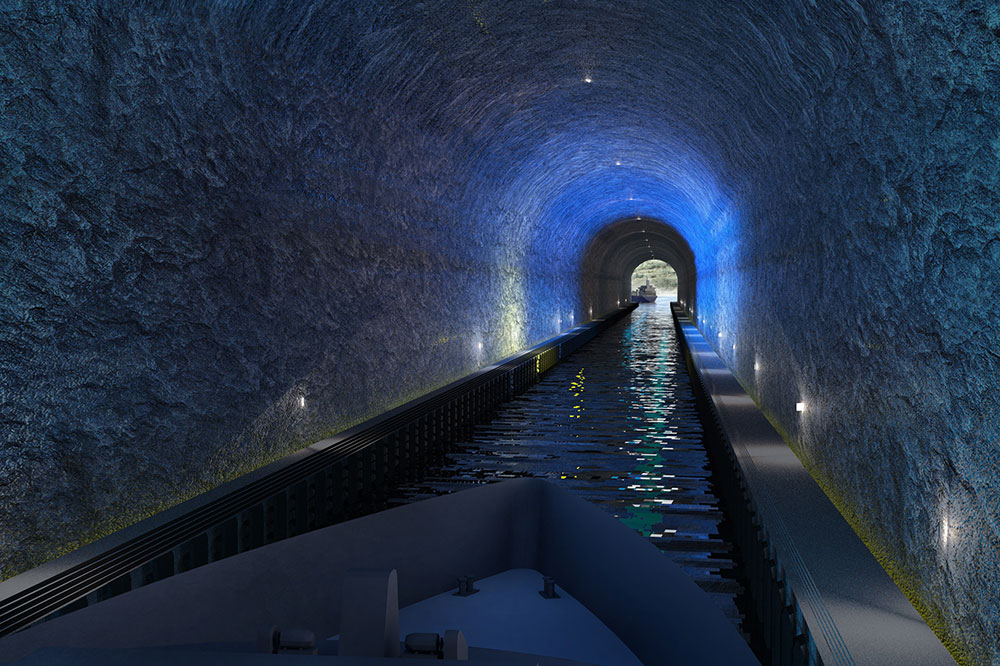
ILLUSTRASJON: KYSTVERKET / SNØHETTA
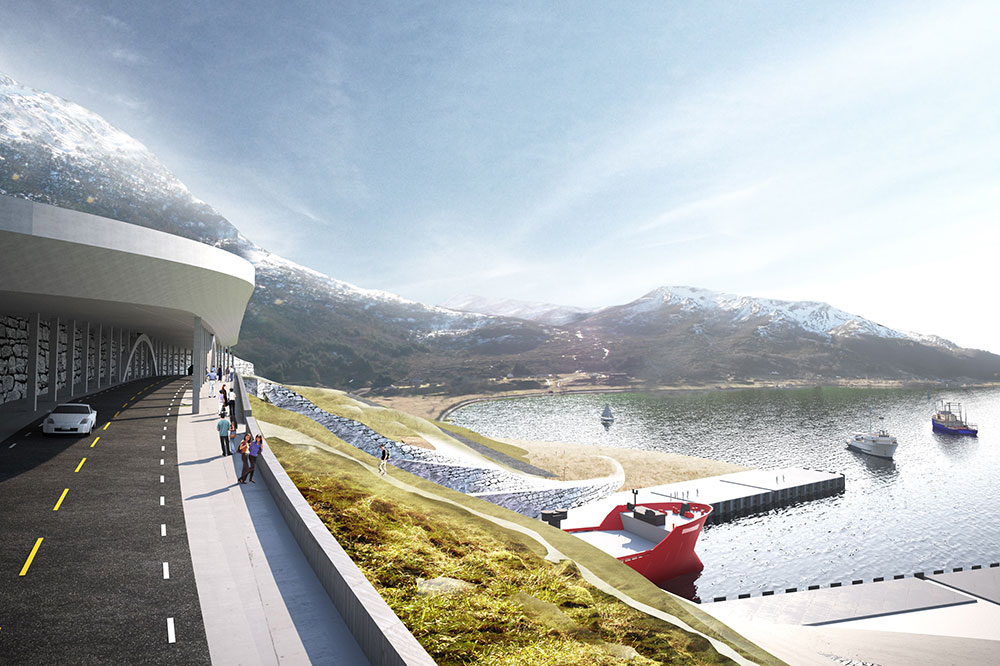
ILLUSTRASJON: KYSTVERKET / SNØHETTA
Facts about the Stad Ship Tunnel
The Stad Ship Tunnel will be the world’s lagrest ship tunnel. The Stad ship tunnel will bo 1.7 kilometers long, 37 meters high, have a width of 36 meters and expected to allow most cruise ships to pass through. According to the Norwegian Coastal Administration, 81 percent of today’s ship traffic can use the tunnel. The tunnel shall not be user-financed, but free passage. The traffic must be directed from the traffic center at the municipality, Fedje. The boats that pass will receive passage times from the traffic center, similar to slot times for aircraft. Commercial traffic will be a priority, especially cruise ships, but pleasure boats and other vessels can also use the tunnel. The speed limit through the tunnel is expected to be eight knots for cruise ships, which will then use approximately 10 minutes for tunnel passage. The construction of the Stad ship tunnel is based on known technology and large amounts of surplus mass can be used to establish new business areas and strengthen existing businesses in the region.
Status of the project
The green light has now been given for the construction of the Stad ship tunnel, and funds have been set aside for the start-up of the Stad ship tunnel in the state budget for 2021. The project is estimated to cost NOK 3.45 billion to build. The Norwegian Coastal Administration believes it is possible to start construction at the end of 2021 and have the opening of the world’s first ship tunnel in 2025.
The construction of the Stad ship tunnel will be more like building a large and long mountain hall than a tunnel and top experts will be used in this type of work. The Norwegian Coastal Administration is planning a conventional blasting with a tunnel drilling rig and pallet rig.
The Minister of Transport, Knut Aril Hareide, said, “The Stad ship tunnel is an exciting project that is unique in a world context. It has been a long journey, and the funds have not always been sufficient. After the budget negotiations, money has been received for start-up in 2021. This means that the project will be completed. This is a big day for the north-western country.”
Realization of the Stad ship tunnel is good:
- Transportation policy
- Environmental and climate policy
- Business policy
- District policy
“We depend on good and safe transport solutions to take away the growth in the seafood industry. That is why we support Stad Ship tunnel.” Regional director of Mowi, Asgeir Hasund